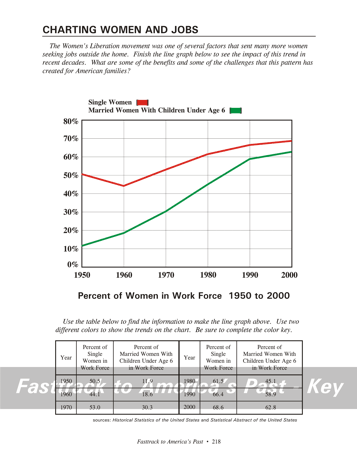| Fasttrack
to America's Past Teacher Key |
|
| Fasttrack
to America's Past Teacher Key |
|
 Page 218 |
Page 218 -
Charting Women and Jobs Making the chart You will need two color pencils for this line graph. Red and green are good choices. Use red for the category "Single Women," placing small dots for the data found in the table under that heading. Connect the dots with straight lines to make the graph line. Be sure to add the color to the key at the top. Then use a green color pencil to place dots for the data in the table under the heading for married women with children. Connect the dots with the green pencil, and complete the key. What the chart shows This chart shows that married and unmarried women were increasingly taking paying jobs during the period from 1950 to 2000. A short downturn for single women early in the period quickly reversed itself. The most remarkable trend is seen in the category of married women with young children. In the 1950s, the vast majority of women in that category were full-time homemakers. But the number with paid jobs was growing steadily. By 1970 the figure hit 30 percent, and it reached 50 percent by the mid-1980s. Keep in mind that the chart shows women in the paid work force. For example, in the 1950s, when relatively few married women with children held paying jobs, a substantial number were working in volunteer positions such as PTAs and other community groups. Background for the chart question The movement of women into the paid labor
force during
this period brought both benefits and challenges to American families. But the changing pattern of women in the
workplace created
some difficult questions for families and American society. The
difficulty of finding good, affordable child care became a serious
national issue. Balancing family time with work responsibilities
was not always easy. In addition, many working women often felt
they were missing out on the personal fulfillment of being with their
children each day as they were growing up. |
|
Copyright Notice
Copyright 2018 by David Burns. All rights reserved. Illustrations and reading selections appearing in this work are taken from sources in the public domain and from private collections used by permission. Sources include: the Dover Pictorial Archive, the Library of Congress, The National Archives, The Hart Publishing Co., Corel Corporation and its licensors, Nova Development Corporation and its licensors, and others. Maps were created or adapted by the author using reference maps from the United States Geological Survey and Cartesia Software. Please see the home page for this title for more information. |